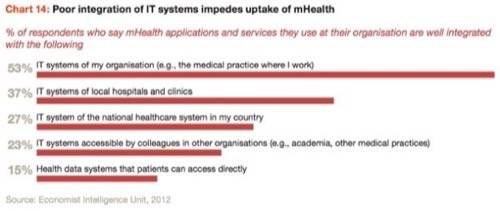mHealth is an emerging trend in technology. It stands for ‘mobile healthcare’ and means utilizing smartphones and medical mobile devices to help diagnose and monitor health conditions. According to a new research paper from the Economist Intelligence Unit (commissioned by PwC), the adoption of mHealth will be slow in the healthcare industry. That’s due to complexities and technology incompatibilities. However, there is more immediate hope with the thousands of consumer mHealth apps available on smartphones.

Healthcare is “moving towards a precision-based model — or ‘personalised medicine’.” The report cites a greater understanding of the human genome, together with other personalised technologies. mHealth apps are uniquely positioned to take advantage of this transition in healthcare, thanks to their mobility and ability to use smartphone sensors.
According to Michael Esquivel writing on the blog Mobile Health Market News, there are two main types of mHealth products. He describes them as “mobile health apps as medical devices and mobile health apps as consumer devices.” The latter are mainly diet and exercise apps, which don’t need to be regulated. The former are medical devices that will require regulation by the FDA, as they will be deployed by hospitals, doctors and ACOs (accountable care organizations).
Consumer mHealth Apps
There has been a tremendous amount of activity in mHealth consumer apps. MobiHealthNews did a detailed study earlier this year and discovered more than 13,600 iPhone health and fitness apps in the App Store. However, many of these apps are unsatisfactory because they require too much manual input of data. Consumers tire quickly of these apps and lose motivation to update them.

We see the real potential of mHealth consumer apps being twofold:
1. Automated data collection, along with meaningful, actionable analysis of that data. For example, as a Type 1 diabetic, it would be wonderful to have an iPhone app that wirelessly connects to my glucose monitoring device. So that when I enter a blood sugar level reading into my monitor, it syncs with an iPhone app to store and analyze the data.
To increase automation, apps need to make more use of the sensors in a modern smartphone. An Israeli company is taking that a step further, by creating a brand new smartphone that is packed with sensors: the LifeWatch V. It will become available in 2013 and will allow you to monitor things like your heart rate and glucose levels.
2. Moving beyond diet and exercise apps. As noted above, the first wave of mHealth consumer apps have been focused on tracking your diet and fitness. There is great potential to move beyond that. Brian Dolan of MobiHealthNews gave a good example of an emerging app type: an app for seasonal allergy management.
Medical mHealth Apps
As for medical apps for hospitals, doctors and ACOs, those face a variety of challenges. As the Economist Intelligence Unit report put it:
“Innovation in healthcare — particularly disruptive reorganisations of processes, care pathways and even job responsibilities — is famously difficult and slow. Although mHealth has a broad range of potential uses and benefits, a common set of powerful barriers also exists. These are both diverse — ranging from technology to culture, from incentive structures to regulations – and mutually reinforcing.”
Poor integration of mHealth apps into existing healthcare IT is just one of those challenges. As the chart below shows, only 53% of doctors say that the mHealth apps they use work within their organisation’s IT system.

Nevertheless, there are opportunities for innovation in medical mHealth apps. For example, apps “prescribed” by healthcare practitioners. MobiHealthNews has noticed an increasing number of physical therapy apps:
“We counted almost three dozen PT app launches over the past year, which made for a noticeable new contingent. The PT apps often focused on one specific issue, like how to help your shoulder rebuild and heal after surgery.”
As you can see, there are new and innovative mHealth apps coming out. But the mHealth revolution will be necessarily slow, especially in regards to medical apps. If you’ll pardon the pun, we consumers will just have to be patient.










